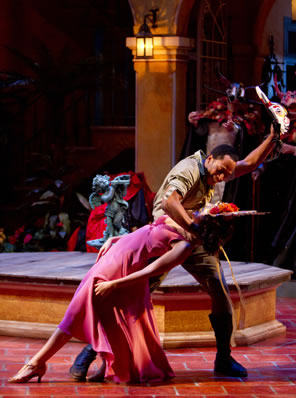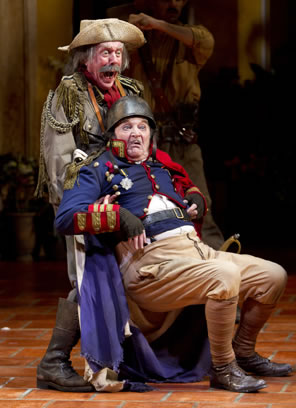Much Ado About Nothing
A Cuban Coupling Brings
Much Sweat to This Sweet Ado
Shakespeare Theatre Company, Harman Hall, Washington, D.C.
Tuesday, February 8, 2011, D–120&121 (center left stalls)
Directed by Ethan McSweeny

Rachel Spencer Hewitt (Margaret) and Mark Hairston (Borachio) tango in Much Ado About Nothing. Photo by Scott Suchman, Shakespeare Theatre Company.
If it accomplished nothing else, Ethan McSweeny’s transferring Much Ado About Nothing from 1590s Messina to 1930s Cuba was worth watching Rachel Spencer Hewitt and Mark Hairston tango. Adding a dollop of Dancing with the Stars to my Shakespeare is fine by me, especially when the all-around outstanding ensemble dancing during the masque centered on the passionate athleticism of Hewitt and Hairston in the play’s centerpiece roles of Margaret and Borachio.
Huh?
This play has been ubiquitously known as “Beatrice and Benedick” since the 1630s, but Margaret and Borachio are the hub of the main plot, as it is their staged rendezvous that convinces Claudio and Don Pedro to disgrace Hero in the chapel and Borachio’s bragging that undoes the mischief (as Kathryn Meisle, who played Beatrice, pointed out in an after-show talkback, Beatrice and Benedick are Much Ado’s subplot). In this production, Hairston’s feral Borachio prowled all over the stage, noting everything and anything that could assist the scheming Don John (Matthew Saldivar in a performance of brilliant stillness harboring real villainy). McSweeny also gave Margaret background presence in more scenes than the text calls for, but more importantly he cut little if any of the lines Shakespeare gave her. In Hewitt’s sexy, slinky performance, this was a Margaret not only delicious to watch tangoing with Borachio but a delight to hear tangling with the witty tongues of Beatrice and Benedick. Carefree to a careless degree, Margaret could foresee no consequence of her rendezvous with Borachio, and so displayed both remorse and fright when Hero was accused. Yet, even before being formally absolved she could easily transition back into a joy-riding flirt.
The 1930s Cuban sugar plantation was not merely an allegorical setting. “Si, señor” was part of the players’ lexicon, Borachio was paid in pesos instead of ducats, Hero’s wedding gown was compared to that of Hedy Lamarr’s instead of the Duchess of Milan, and Hugh Otecake and George Seacole of the Watch were renamed Juan Huevos and José Frijoles. Lee Savage’s set was as detailed as an Ybor City courtyard, from the louvered doors on the ironwork balconies to the burnt-red tile floor, from the water pump and various vessels at stage right to a fountain topped by a statue of Cupid in the center (Benedick conversed with Cupid in his soliloquy on love; Beatrice used the fountain as a hiding place in her gulling scene). Tyler Micoleau’s lighting provided the passing of summer days: the morning sun’s orange beams peering through window slats, the courtyard bathed in hot noontime sun prompting Margaret to cool off in the fountain, the setting sun casting shadows under the arches.
In the wake of a 1933 populist revolution, Cuba developed its own richly exotic cultural identity but still maintained the hierarchic society of the plantations, a stout code of honor, and a strong regard for the Catholic Church. McSweeny saw this setting coaxing out both the social and gender stratification inherent in the play. The women filled archetypal roles: a bookish Ursula (Colleen Delany) suppressing sexual urges, the vixenish Margaret unable to suppress any urge, and a Hero (Kate Hurster) determined to be a devout daughter, wife, and Catholic. Claudio’s accusations in the chapel therefore came at her out of nowhere and understandably knocked her senseless.
The men were equally cast into roles dictated by their society, including Lawrence Redmond’s Friar Francis, the most commanding I’ve ever seen in this play. He didn’t just protest Hero’s innocence, he quieted Leonato by roaring forth a lecture that had all the confidence of a man in God’s employ. Claudio (Ryan Garbayo) was a hotheaded young man learning not only the trade of war but also the path of duty and the ways of wooing under the ever-watchful eyes of Don Pedro (David Emerson Toney). The two elderly brothers were old-school honor-code champions: Bev Appleton’s Antonio had a pistol ready for upholding the house’s name.
Adrian Sparks played Leanoto as a benevolent patron: kind to guests, loving to his family, genuinely moved to histrionic dismay at his daughter’s “foul-tainted flesh,” and subsequently braving anger at both Claudio and Don Pedro. While Sparks’ portrayal was possibly the most textured Leonato I’ve ever seen, his reading of the part differed little from most I’ve seen. However, the Cuban sugar plantation setting could have informed a different dimension to Leonato, one with a despotic bent, not unlike Baptista in Taming of the Shrew and Capulet in Romeo and Juliet. This is a man who gives courtly rather than warm welcome to Don Pedro, shows more concern for his reputation than his daughter in the chapel scene, and commandeers the priest's plot in the fifth act. Such a Mafioso boss in Messina could give Claudio a reckoning the youth wouldn’t fully comprehend but Don Pedro would respect. Just a thought.
Which brings us to the play's social stratification. The constable and his watch were poor, uneducated peasants who knew their places. Dogberry’s instructions to the Watch were most revealing in this light: For example, if a man does not stand when accosted, “Why, then, take no note of him, but let him go, and presently call the rest of the watch together, and thank God you are rid of a knave.” This same thinking goes into Conrad and Borachio being arrested for slandering Don John rather than for their part in the prince's villainy. Though socially apt, this reading did not seep the comedy out of these scenes. In fact, Ted van Griethuysen and Floyd King restored Dogberry and Verges to their proper places in the upper tier of Shakespearean comic characters. Van Griethuysen used an old pro’s timing to glean more humor in Dogberry’s lines than perhaps even Shakespeare knew was there. King gave old Verges a gait and bearing that had him constantly lagging just a second behind the action. This was Laurel and Hardy, except that their attempts at wit tended to misfire, and Dogberry’s attempt to be impeccably mannered lost much in the translation from his imagination to what his mouth, hands, and body actually did.

Floyd King (Verges), left, and Ted van Griethuysen (Dogberry). Photo by Scott Suchman, Shakespeare Theatre Company.
In the strict order of this 1930s Cuban society—as well as that of 1590s Messina and Shakespeare's Elizabethan London—Benedick and Beatrice didn’t fit in. Both tried to abide by the social codes assigned them, but, really, they just wanted to live a life to their liking unbound by conventions or expectations and full of intelligent, good company. That is the beauty of Beatrice and Benedick in any setting: Shakespeare has given us two characters and a mature love story so singular and yet so real they not only dominate this play, they set the standard for a class of fictional couples that have followed, from Restoration comedy right through Tracy and Hepburn up to Bullock and Reynolds.
Derek Smith and Kathryn Meisle served these two now-iconic characters well (Meisle stepped into the role when the original Beatrice, Veanne Cox, departed over “artistic differences” two weeks before opening night). They brought a real sense of vulnerability to their parts, their public bravado masking deeply seeded self-doubt. Impervious to all others, it was only each other’s verbal poniards that could stab their fragile self-esteems. Thus they grated so on each other even though they were the most interesting aspects of each others' lives. Beatrice and Benedick are best known for their wars of wit in the first portion of the play as well as for their gulling in the middle. In this production the former sparkled with combustible chemistry between Smith and Meisle, and the latter were superbly staged: Leonato, Don Pedro, and Claudio getting confused over their scripts while Benedick scampered to different hiding places, including behind a chambermaid; an uncharacteristically impish Hero watering the flowers where Beatrice was hiding.
However, Smith and Meisle found greater revelations in the last third of the play with Benedick’s and Beatrice’s awkward handling of courtship. Theirs was a halting, fumbling romance, each not quite able to let go of their self-image and wariness even as they wanted to please the other. The final scene was most telling: learning that neither had actually professed any love for the other freed them of an obligation to love, so when their secret notes unveiled their true feelings, Beatrice and Benedick could now freely embrace what they both had feared—the other's brutal wit—and turn their own self-doubt to confidence in love (wonderful moment as each read the other’s lettes; we could tell from the actors’ expressions and gestures that Beatrice’s note was elegant and loving, and that Benedick’s was sappy but admiring.)
Their tangling now a tango, it was only right that the socially awkward Benedick demanded dancing to end the play, and as another energetic Spanish dance ensemble commenced, he and Beatrice were the undeniable centerpieces.
Eric Minton
December 9, 2011
After hearing complaints from the Latino community, the Shakespeare Theatre Company returned to Shakespeare's original text with the names of the two members of The Watch, Hugh Otecake and George Seacole, even reprinting the program. "This was obviously an inadvertent mistake, and it certainly has raised my consciousness of what can be a slight," Artistic Director Michael Kahn was quoted in The Washington Post. "I used to get letters from people about why we would have black and white actors playing members of the same family. Sometimes I wouldn't even answer them because I thought it was their problem. This I think is our problem, and it will never happen again."
December 20, 2011
Comment: e-mail editorial@shakespeareances.com.
Start a discussion in the Bardroom



 Find additional Shakespeareances
Find additional Shakespeareances